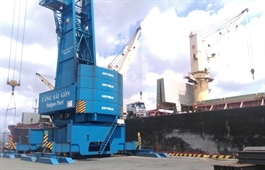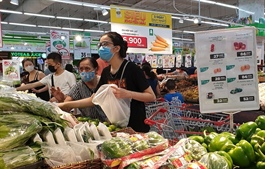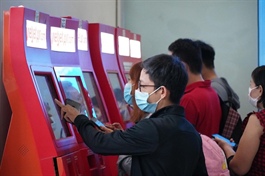Digital capabilities driving the e-commerce revolution
Digital capabilities driving the e-commerce revolution
Despite the tumultuous recent years, cross-border e-commerce is accounting for over one-third of Vietnam’s total e-commerce revenues and the number is only expected to grow.
On June 8, Amazon Global Selling Vietnam announced an initiative in collaboration with the Vietnam E-commerce and Digital Economy Agency (iDEA) under the Ministry of Industry and Trade (MoIT), aiming to support the development of cross-border e-commerce talents for Vietnam in the next five years. The project is expecting the participation of 10,000 Vietnamese businesses.
“We believe the key is to equip Vietnamese businesses and communities with updated knowledge about policies and skills in e-commerce and digital economy applications,” said Dang Hoang Hai, general director of iDEA. “This initiative is a tailor-made programme with a dedicated training agenda which aligns with our direction to support enterprises to improve their digital capabilities and participate in digital economy activities.”
Nearly 90 per cent of 300 micro, small, and medium-sized enterprises (MSMEs) in Vietnam surveyed in a new Amazon report feel that e-commerce is critical for their ability to export their goods. More than 40 per cent of Vietnamese MSMEs anticipate greater sales growth overseas than in their home country.
Digital capabilities driving the e-commerce revolution - illustration photo/ Shutterstock
The iDEA states that Vietnam’s e-commerce development speed is relatively high in the region, with the highest growth rate among regional markets in the past three years. With global business-to-customer (B2C) e-commerce sales expected to reach $2.88 billion in 2023, cross-border e-commerce will be an effective channel for Vietnamese goods to reach the global market.
“Along with opportunities from free trade agreements, switching from traditional business models to digital platforms is helping businesses expand their markets, as Vietnam is increasingly integrating with the world economy,” Deputy Minister of Industry and Trade Nguyen Sinh Nhat Tan remarked.
The great benefits of digital transformation in import-export include creating favourable conditions for enterprises to participate in international trade activities and saving time, costs, and efforts, according to Tan, thereby promoting Vietnam’s trade activities.
Ly Huy Sang, deputy general director of porcelain maker Minh Long I, shared that in order to achieve the company’s vision of becoming the leading global ceramic brand, Minh Long’s products must be accessible to customers around the world. While the company previously utilised mainly traditional distribution channels such as stores and showrooms, over past years, e-commerce has become a strategic focus.
“Since last September, when our first ceramic products appeared on a global online platform, we have witnessed an increase in sales and positive feedback from consumers. This has not only meaning in terms of revenues, but it’s also rewarding to witness overseas customers’ interest in our designs and products,” Long noted.
Likewise, Seagrapes Vietnam is another company that has seen tremendous revenue growth from cross-border e-commerce participation. Tran Van Tuoi, CEO of Seagrapes Vietnam commented, “In 2020, sales from our global e-commerce contributed nearly 35 per cent to total revenues. Particularly during the last holiday season, we recorded a 300-500 per cent increase in sales. Besides improving product quality, choosing an optimal e-commerce channel is considered half of the success now.”
However, amidst the opportunities for growth through e-commerce, businesses also face several challenges in this global expansion effort – mainly barriers in cost, regulation, and capabilities.
More than 80 per cent of surveyed local MSMEs in the Amazon report admitted that they lack information on relevant regulations overseas. About 85 per cent believe they lack the ability to compete with other sellers globally, and 81 per cent feel unsure of foreign consumers’ demands and preferences.
In this context, the Vietnamese government has pursued various efforts to facilitate local businesses’ participation in global e-commerce.
The National E-commerce Development Master Plan for 2021-2025 approved by the government aims to increase national presence on some of the world’s major e-commerce platforms through constructing “Vietnamese Pavilions”, where prestigious brands with highly localised content are concentrated. By the end of 2021, such a pavilion was listed on China’s jd.com, which was the first B2C Vietnamese booth on an international e-commerce platform.
Also in 2021, the iDEA cooperated with Viettel Post and e-commerce platform Voso to pilot exports of Bac Giang lychees to the European market. This effort was a remarkable step in digital market expansion considering Europe’s strict standards for cross-border agricultural products.
Aside from efforts from the government, businesses are also taking initiatives to overcome challenges. Sang of Minh Long I shared that, besides finding a suitable platform to partner with, a prerequisite for successful penetration in the international market is product development and investment in specialised human resources.
“For every launch, we carefully review market segments to come up with corresponding designs that can meet the different needs of each customer group. The company has also appointed dedicated staff for cross-border e-commerce channels to manage products, carry out marketing and market research, and understand the tastes of customers in other countries,” Sang noted.




















